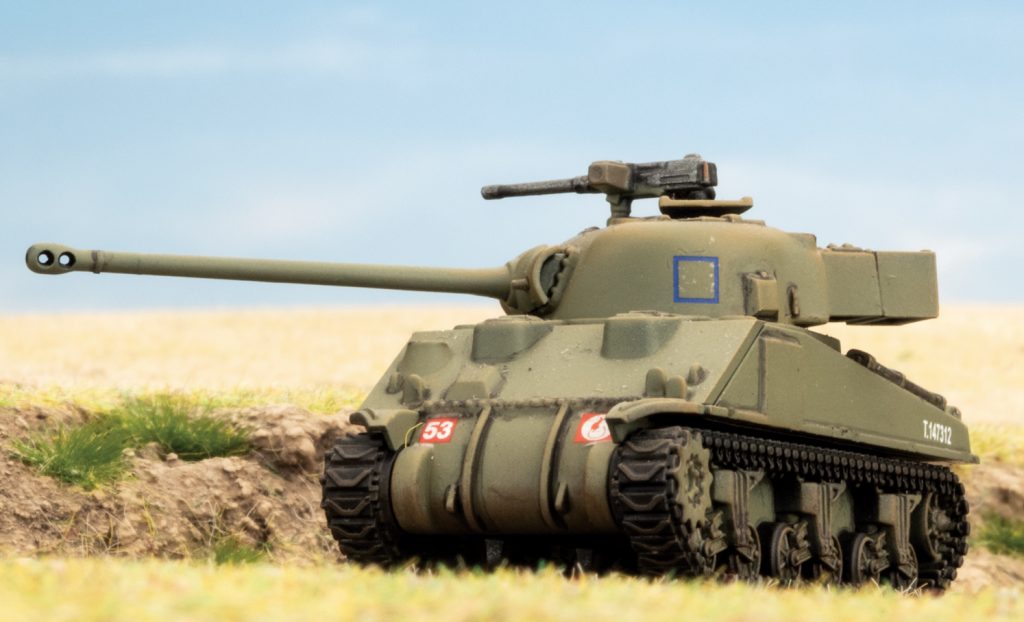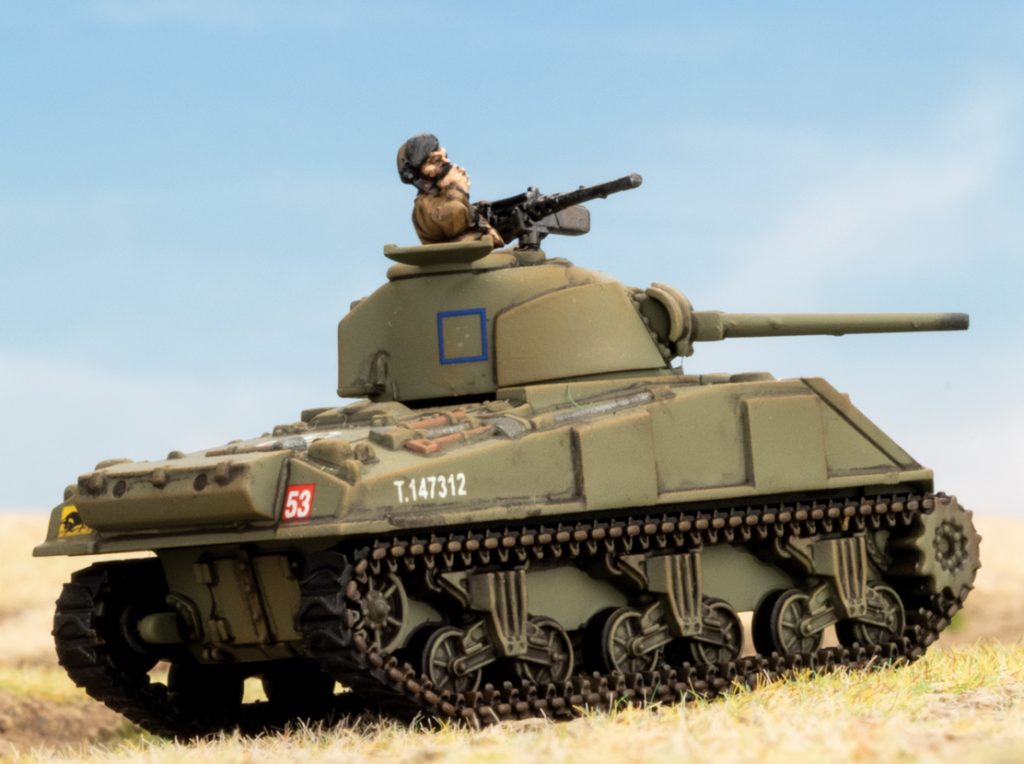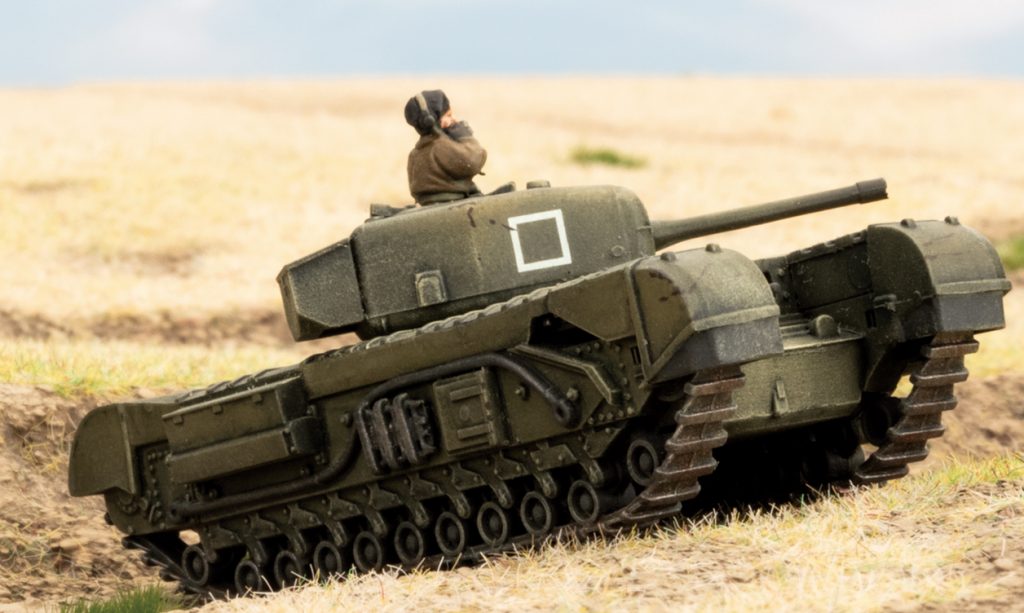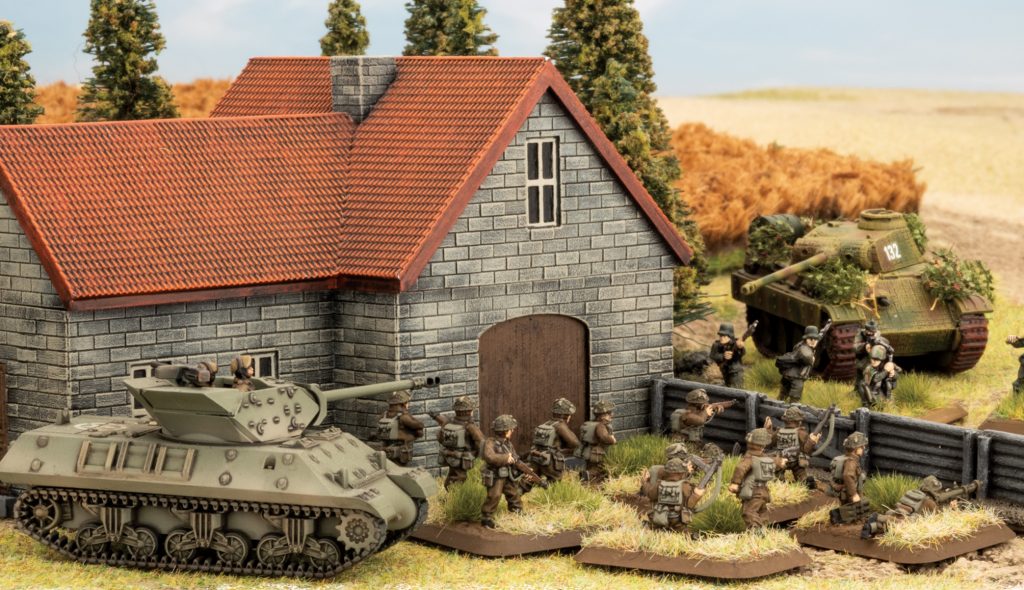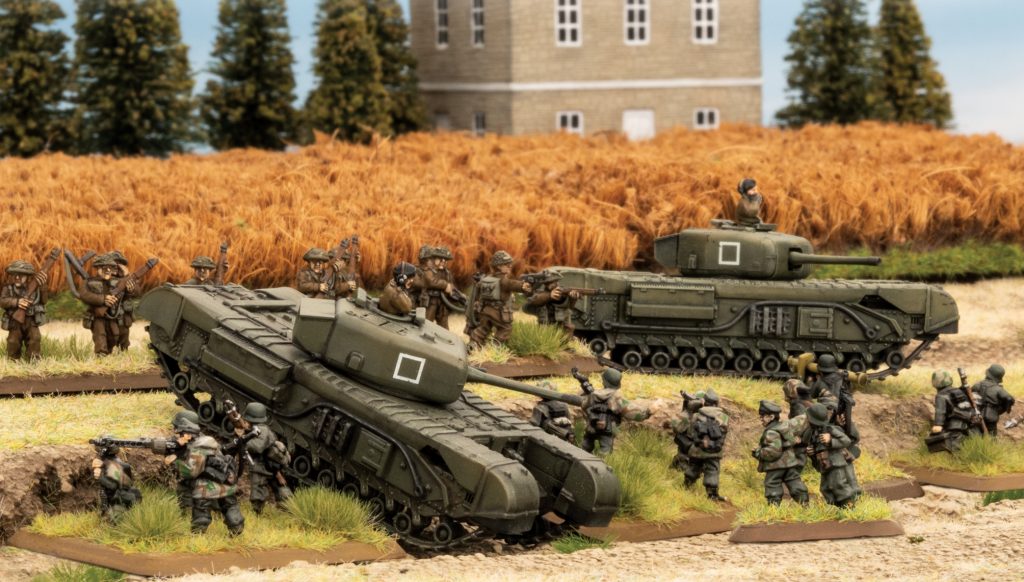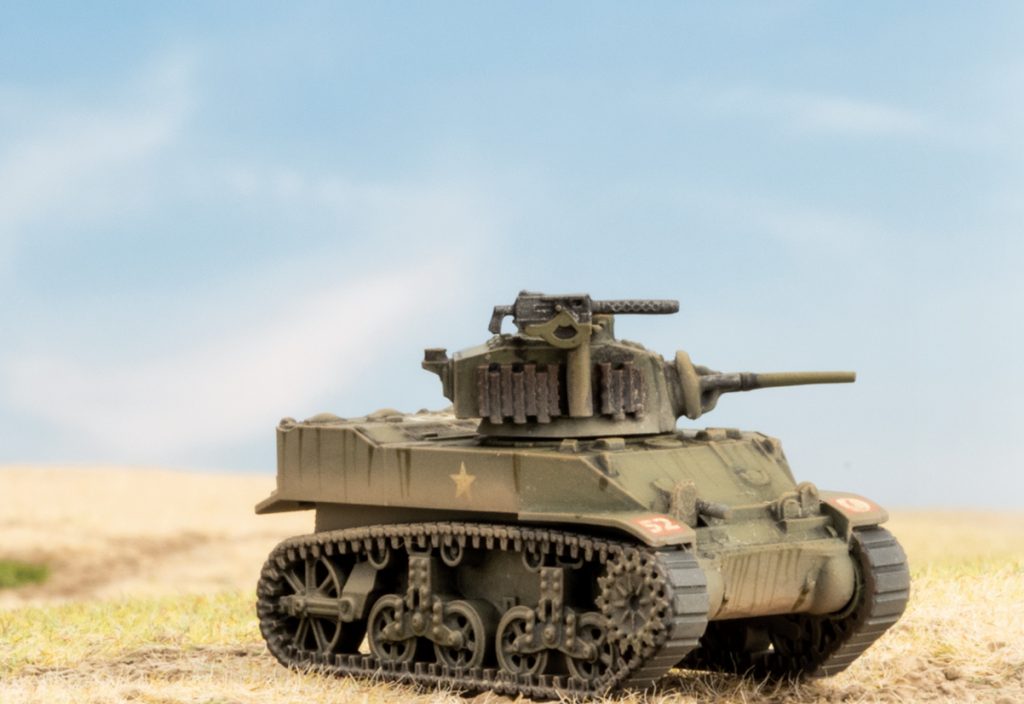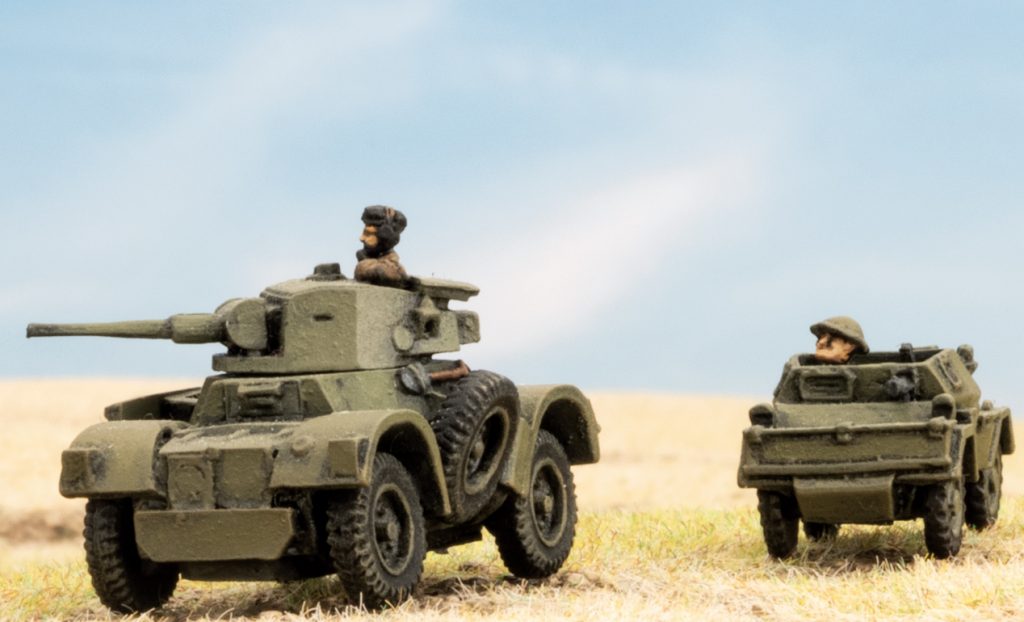with Phil Yates
After defeating the Germans and Italians in North Africa, the British took the fight to the enemy, invading Italy. At this point, the British Army was in transition from the Desert Rats of Africa to the much larger army that invaded France on D-Day. This book covers that transition. You can either build a mid-war style force to fight in Italy, or get a head start on a British force for the battles in Normandy.
The workhorse of the British armoured forces is the venerable 75mm-armed Sherman tank. After encountering the new generation of German heavy tanks, the British developed the Sherman Firefly, replacing the 75mm gun with a 17pdr gun. Typical platoons mix Shermans and Fireflies together to make cheap, versatile platoons that are capable of handling most situations, especially when backed by their motor infantry platoons.
Some situations require a bit more armour. The Churchill maybe slower than the Sherman, but its heavier armour means it can take heavier hits. Churchills are ideally paired with infantry, where their lack of speed is not a problem.
British infantry are assault experts, hitting hard and then staying put. On top of this, in the right situation, rifle companies can launch night attacks—giving them much needed cover as they rush towards their objectives.
A British force is like a golf bag, it has a club for every stroke. The key is picking the tool for the job at hand.
Sherman Armoured Squadron
- Uses same Sherman tanks as Mid War. The organisation is almost identical, so easy to transfer across.
- Upgrade with Firefly (17 pdr) for extra anti-tank capability, and add Stuart recce patrols for extra sneakiness.
- Solid, cost effective medium tanks with the option of a nasty surprise for enemy heavy tanks.
Churchill Italy Armoured Squadron
- Same organisation and equipment as Mid War, so easy to transfer across.
- Flexibility to mix Churchill and Sherman units, and to add Stuart recce patrols for extra sneakiness.
- Tough, slow, infantry tanks to grind their way through the enemy.
Rifle Company
- Same organisation and equipment as Mid War, so easy to transfer across.
- Tough, assault-oriented infantry.
- Formation has integrated heavy machine-guns, mortars, anti-tank guns, and reconnaissance.
- 6 pdr anti-tank guns have better anti-tank with the latest ammunition.
- Lots of carriers as armoured elements for scouting, flank protection, and raiding.
- Use night attacks to overrun the enemy before they see you clearly.
Motor Company
- Similar organisation and equipment to Mid War, with more infantry platoons available, so easy to transfer across.
- Small infantry units with lots of firepower, backed up with integrated heavy machine-guns, mortars, anti-tank guns, and reconnaissance.
- 6 pdr anti-tank guns have better anti-tank with the latest ammunition.
- Lots of carriers as armoured elements for scouting, flank protection, and raiding.
- Great for holding ground while the armour takes the fight to the enemy.
Support
- Similar organisation and equipment to Mid War, so easy to transfer across, although obsolete equipment like Humber armoured cars and Hurricane tank-busters are no longer available.
- New M10 self-propelled anti-tank gives the British excellent anti-tank, particularly with the upgunned 17 pdr version.
- Three batteries of 25 pdr or self-propelled M7 Priest artillery give British forces powerful artillery support.
- Mike Target rule allows multiple artillery batteries to range in quickly for rapid and effective artillery support.
How Do the British Play?
The Germans in Fortress Europe are among the last of the old guard, trained before the tide turned, in the days when Germany was winning the war. They are rated as Confident, Veteran, and Careful, so are some of the best trained and most experienced troops available. Their faith in the thousand-year ‘Third Reich’ gives them a better Last Stand rating, so you can trust them to hang in there, even when things look bad.
This training follows in the footsteps of their legendary forebears, the stormtroopers of the First World War. Their Stormtroopers ability allows German troops to attempt two movement orders in each turn. Combined with their high skill rating, this allows them to fight with a finesse that no other army can match.
To go with this superb level of tactical prowess, German engineering provides you with the best tanks, such as the Panther and Tiger, and the most powerful guns, like the long 8.8cm which can penetrate any tank with ease. Even older tanks like the Panzer III have been brought up to the latest standards with bazooka skirts and HEAT ammunition.
In summary, a successful German force will use their superiority in equipment, training, skill, and cleverness, combined with a good dose of aggression, to keep the initiative, hit the enemy in their weak spots, while minimising the enemy’s opportunities to hit them back.
What to Expect in D-Day: British
Fortress Europe forces will transfer easily to D-Day: British and form the basis of solid Late War forces, ready to add on all the new kit that will appear. D-Day will bring new tanks like the speedy Cromwell and unarmoured and upgunned late-model Churchills — including the savage Churchill Crocodile flame-thrower, the most powerful flame-tank in existence. For air support, they’ll have the frighteningly-effective rocket-firing Typhoon fighter-bombers.
To reflect the harsh fighting in Normandy, D-Day: British will have two flavours. The fresh divisions are a little less eager to walk into the meat grinder than the troops in Italy, demanding heavy fire support to suppress the enemy, while the old hands of the Desert Rats are wondering why they are still leading the charge with untried troops sitting in Britain, so are reluctant to take unnecessary risks.
There will be lots of totally new options for a whole new D-Day force as well.
This isn’t to say that a force from Fortress Europe will be superseded. The troops in Italy can still hold their own against any comers, the ‘D-Day Dodgers’ just don’t have as many flash new toys as the troops in Normandy. Whether you stay in Italy, or are preparing to land in Normandy, Fortress Europe is the place for any British player to start their journey.


